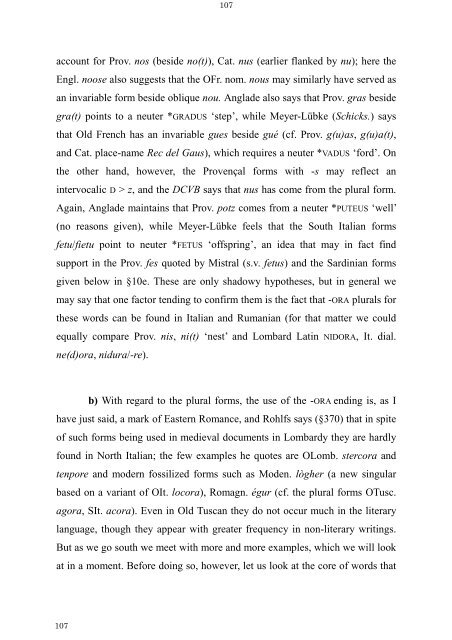The Latin Neuter Plurals in Romance - Page ON
The Latin Neuter Plurals in Romance - Page ON
The Latin Neuter Plurals in Romance - Page ON
You also want an ePaper? Increase the reach of your titles
YUMPU automatically turns print PDFs into web optimized ePapers that Google loves.
107<br />
107<br />
account for Prov. nos (beside no(t)), Cat. nus (earlier flanked by nu); here the<br />
Engl. noose also suggests that the OFr. nom. nous may similarly have served as<br />
an <strong>in</strong>variable form beside oblique nou. Anglade also says that Prov. gras beside<br />
gra(t) po<strong>in</strong>ts to a neuter *GRADUS ‘step’, while Meyer-Lübke (Schicks.) says<br />
that Old French has an <strong>in</strong>variable gues beside gué (cf. Prov. g(u)as, g(u)a(t),<br />
and Cat. place-name Rec del Gaus), which requires a neuter *VADUS ‘ford’. On<br />
the other hand, however, the Provençal forms with -s may reflect an<br />
<strong>in</strong>tervocalic D > z, and the DCVB says that nus has come from the plural form.<br />
Aga<strong>in</strong>, Anglade ma<strong>in</strong>ta<strong>in</strong>s that Prov. potz comes from a neuter *PUTEUS ‘well’<br />
(no reasons given), while Meyer-Lübke feels that the South Italian forms<br />
fetu/fietu po<strong>in</strong>t to neuter *FETUS ‘offspr<strong>in</strong>g’, an idea that may <strong>in</strong> fact f<strong>in</strong>d<br />
support <strong>in</strong> the Prov. fes quoted by Mistral (s.v. fetus) and the Sard<strong>in</strong>ian forms<br />
given below <strong>in</strong> §10e. <strong>The</strong>se are only shadowy hypotheses, but <strong>in</strong> general we<br />
may say that one factor tend<strong>in</strong>g to confirm them is the fact that -ORA plurals for<br />
these words can be found <strong>in</strong> Italian and Rumanian (for that matter we could<br />
equally compare Prov. nis, ni(t) ‘nest’ and Lombard <strong>Lat<strong>in</strong></strong> NIDORA, It. dial.<br />
ne(d)ora, nidura/-re).<br />
b) With regard to the plural forms, the use of the -ORA end<strong>in</strong>g is, as I<br />
have just said, a mark of Eastern <strong>Romance</strong>, and Rohlfs says (§370) that <strong>in</strong> spite<br />
of such forms be<strong>in</strong>g used <strong>in</strong> medieval documents <strong>in</strong> Lombardy they are hardly<br />
found <strong>in</strong> North Italian; the few examples he quotes are OLomb. stercora and<br />
tenpore and modern fossilized forms such as Moden. lògher (a new s<strong>in</strong>gular<br />
based on a variant of OIt. locora), Romagn. égur (cf. the plural forms OTusc.<br />
agora, SIt. acora). Even <strong>in</strong> Old Tuscan they do not occur much <strong>in</strong> the literary<br />
language, though they appear with greater frequency <strong>in</strong> non-literary writ<strong>in</strong>gs.<br />
But as we go south we meet with more and more examples, which we will look<br />
at <strong>in</strong> a moment. Before do<strong>in</strong>g so, however, let us look at the core of words that









